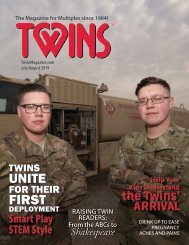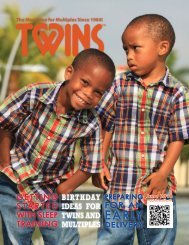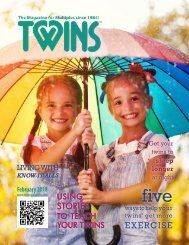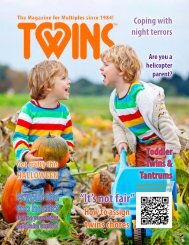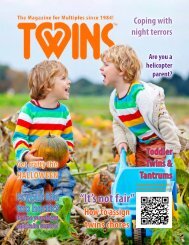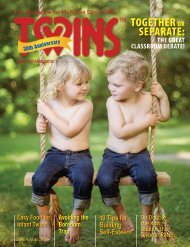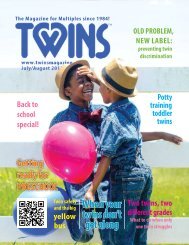2007GuideToTheFirstYear
Create successful ePaper yourself
Turn your PDF publications into a flip-book with our unique Google optimized e-Paper software.
Colic is probably<br />
caused by an<br />
immature digestive<br />
and/or central nervous<br />
system. As many as 1 in<br />
4 twinfants younger than<br />
3 months develop colic at<br />
some point in their first 6<br />
months. Crying jags may<br />
continue for three hours or<br />
more, and may occur three<br />
or four times a week. Don’t<br />
lose hope. Colic is a passing<br />
phase. It won’t affect your babies’ long-term health, either.<br />
Babies who cry because of colic don’t experience any more<br />
pain than those without colic, so don’t worry your babies are<br />
suffering if colicky. Colicky crying is fairly normal. Babies are<br />
hardwired to cry, and some babies are hardwired to do colicky<br />
crying. Colicky crying usually tapers off after 8 weeks, disappearing<br />
by about 6 months. In the meantime, try these steps:<br />
Change your diet. If breastfeeding, avoid foods that can create<br />
gassiness (dairy, beans, onion, caffeine, cabbage, chocolate) or<br />
switch to hypoallergenic formula if twinfants are bottle-fed.<br />
Waiting periods. Try waiting at least 2½ hours between feedings,<br />
and limit each feeding to 30 minutes. This might help calm<br />
the system. Feed your babies in a calm, quiet spot. This often<br />
helps your twins sleep longer and cry less.<br />
Swaddle. Flailing arms and legs can start a crying jag. Swaddling<br />
works. Wrap a fussy<br />
twinfant in a swaddling<br />
blanket to replicate<br />
the sensation of<br />
being in the womb—<br />
prevents a “startle<br />
response” that triggers<br />
MICHAEL AND MATTHEW, AGE 3 MONTHS more crying.<br />
The “colic hold.”<br />
Hold your baby face<br />
down, supporting<br />
him with your forearm<br />
between his legs.<br />
Clasp your hands under his tummy. The pressure of the babies’<br />
own weight puts gentle pressure on the abdominal area.<br />
Back rubs. Lie on your back with your twinfant on your<br />
chest (known as kangaroo-ing); rub your baby’s back.<br />
Pacing. Try the old standard: Hold your baby, and pace the<br />
floor, bouncing.<br />
Music / noise. Play music or sing. Create “white noise” using<br />
a background noise machine, vacuum cleaner, radio static (this<br />
simulates the sound your babies heard while in the uterus).<br />
Change of scene. Go to another part of the house or outdoors<br />
to break the cycle of crying.<br />
Driving. The car’s motion and hum of the engine soothe some<br />
babies.<br />
Swing. Battery-operated swings (and/or vibrating bouncers)<br />
are great for unhappy babies.<br />
Coping With Colic<br />
A Lifetime Keepsake of Your Twinfants<br />
CUSTOM COVERS<br />
Put your multiples on their own<br />
personal Custom Cover from<br />
Twins Magazine. Send your<br />
personal photos and receive a<br />
cover prepared to order.<br />
To order call toll free<br />
1-800-558-9467<br />
or download an order form at www.TwinsMagazine.com<br />
© 2007 TWINS Magazine. To subscribe: call 1-888-55-TWINS or www.TwinsMagazine.com GUIDE TO THE FIRST YEAR 29






